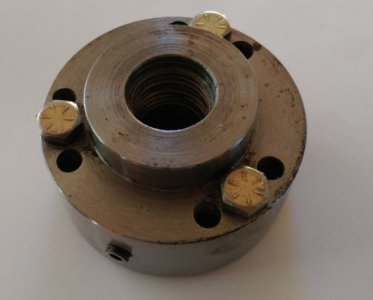- Joined
- Nov 15, 2016
- Messages
- 943
Hello all,
About a year ago I pulled down my 3-jaw chuck as part of a major cleanup after a lot of Cast Iron machining. When I put it back together I noticed I had some bad runout 0.75 mm! Moving the jaws around got this down to 0.5 mm. This chuck had around 0.01 mm runout before the strip down so I pulled it down again and identified the problem as the bolt seats for the bolts that hold the chuck together being unfinished. I think it was in the middle of some holidays at the time so I put it back together to sort out later then as life goes I got a bit busy. Most of the stuff that goes in the 3-jaw is Mysterium that always need a clean up and anything accurate gets done in the 4-jaw and life went on.
I finally got fed up with it and as it was due for a clean anyway decided to sort it out. As it happened just about every time I went on the Youtube something popped up about grinding lathe chuck jaws, Then I picked up some old magazines and found all these articles on truing up chuck jaws. I knew that this chuck had been good and I knew why it was not now so time for some surgery. I decided to make the chuck adjustable to make life easy in the future whenever I pull it down for a clean.
Attached are some photographs of the process. Careful measurement determined that I would need to sink the seats 1.6 mm to clean them up which was fortuitous as that is a standard washer thickness. I could get some hardened washers but they would need to be ground to diameter,(We are a long way away from suppliers that have everything such as in civilised countries),and best price I'd have to buy a 100 of each from South Island. Fortunately a new shop had opened up a few miles away and I bought some packets of A2 SS very cheap. I still had to turn them down to size but that was no biggie.
I didn't have an end mill the correct size for the body seats so ground a drill bit to suit.
Torquing up the bolts was done on the lathe very carefully 5 pound/inch at a time working in a reversing pattern back and forth and measuring runout at each step. I used a Matco pound/inch torque wrench on the front and because of space limitations a ball end Allen key with a small hand scale at the rear. The groove at the top of the ball made a loverly locator for the scale hook.
About a year ago I pulled down my 3-jaw chuck as part of a major cleanup after a lot of Cast Iron machining. When I put it back together I noticed I had some bad runout 0.75 mm! Moving the jaws around got this down to 0.5 mm. This chuck had around 0.01 mm runout before the strip down so I pulled it down again and identified the problem as the bolt seats for the bolts that hold the chuck together being unfinished. I think it was in the middle of some holidays at the time so I put it back together to sort out later then as life goes I got a bit busy. Most of the stuff that goes in the 3-jaw is Mysterium that always need a clean up and anything accurate gets done in the 4-jaw and life went on.
I finally got fed up with it and as it was due for a clean anyway decided to sort it out. As it happened just about every time I went on the Youtube something popped up about grinding lathe chuck jaws, Then I picked up some old magazines and found all these articles on truing up chuck jaws. I knew that this chuck had been good and I knew why it was not now so time for some surgery. I decided to make the chuck adjustable to make life easy in the future whenever I pull it down for a clean.
Attached are some photographs of the process. Careful measurement determined that I would need to sink the seats 1.6 mm to clean them up which was fortuitous as that is a standard washer thickness. I could get some hardened washers but they would need to be ground to diameter,(We are a long way away from suppliers that have everything such as in civilised countries),and best price I'd have to buy a 100 of each from South Island. Fortunately a new shop had opened up a few miles away and I bought some packets of A2 SS very cheap. I still had to turn them down to size but that was no biggie.
I didn't have an end mill the correct size for the body seats so ground a drill bit to suit.
Torquing up the bolts was done on the lathe very carefully 5 pound/inch at a time working in a reversing pattern back and forth and measuring runout at each step. I used a Matco pound/inch torque wrench on the front and because of space limitations a ball end Allen key with a small hand scale at the rear. The groove at the top of the ball made a loverly locator for the scale hook.




























